This article needs to be updated.(February 2023) |
Crystal LED (CLED) refers to a screen manufacturing technique. It was invented by Sony and revealed at CES 2012.
This article needs to be updated.(February 2023) |
Crystal LED (CLED) refers to a screen manufacturing technique. It was invented by Sony and revealed at CES 2012.
This technology makes use of light emitting diodes mounted on each segment RGB of the display, such that each pixel is illuminated independently. This makes it the first "true" LED television. [1] [2]
Sony unveiled Crystal LED display technology in the CES 2012. [3] [4]
The following year, the company was deciding between CLED and OLED, and did not display CLED at the 2013 CES, but produced an OLED instead. [5]

At CES 2017 Sony showcased the CLEDIS ™ (Crystal LED Integrated Structure) with a Crystal LED video wall approximately 32 by 9 feet (9.7 x 2.7 meter) with a resolution of 8000 x 2000 pixel. According to Sony, it is composed of single display modules measuring 17 7/8" (463.6mm) by 15 7/8" (403.2mm) each.
The individual modules were not visible to the human eye. Due to the modular structure of the system theoretically, any resolution and size could be possible according to a Sony representative. [6]

A liquid-crystal display (LCD) is a flat-panel display or other electronically modulated optical device that uses the light-modulating properties of liquid crystals combined with polarizers. Liquid crystals do not emit light directly but instead use a backlight or reflector to produce images in color or monochrome.
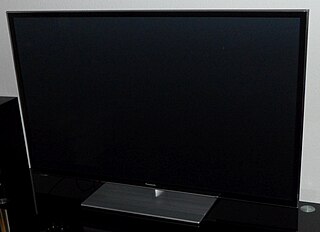
A plasma display panel (PDP) is a type of flat-panel display that uses small cells containing plasma: ionized gas that responds to electric fields. Plasma televisions were the first large flat-panel displays to be released to the public.

An organic light-emitting diode (OLED), also known as organic electroluminescentdiode, is a type of light-emitting diode (LED) in which the emissive electroluminescent layer is an organic compound film that emits light in response to an electric current. This organic layer is situated between two electrodes; typically, at least one of these electrodes is transparent. OLEDs are used to create digital displays in devices such as television screens, computer monitors, and portable systems such as smartphones and handheld game consoles. A major area of research is the development of white OLED devices for use in solid-state lighting applications.

CES is an annual trade show organized by the Consumer Technology Association (CTA). Held in January at the Las Vegas Convention Center in Winchester, Nevada, United States, the event typically hosts presentations of new products and technologies in the consumer electronics industry.

A flat-panel display (FPD) is an electronic display used to display visual content such as text or images. It is present in consumer, medical, transportation, and industrial equipment.
A television set or television receiver is an electronic device for the purpose of viewing and hearing television broadcasts, or as a computer monitor. It combines a tuner, display, and loudspeakers. Introduced in the late 1920s in mechanical form, television sets became a popular consumer product after World War II in electronic form, using cathode ray tube (CRT) technology. The addition of color to broadcast television after 1953 further increased the popularity of television sets in the 1960s, and an outdoor antenna became a common feature of suburban homes. The ubiquitous television set became the display device for the first recorded media for consumer use in the 1970s, such as Betamax, VHS; these were later succeeded by DVD. It has been used as a display device since the first generation of home computers and dedicated video game consoles in the 1980s. By the early 2010s, flat-panel television incorporating liquid-crystal display (LCD) technology, especially LED-backlit LCD technology, largely replaced CRT and other display technologies. Modern flat panel TVs are typically capable of high-definition display and can also play content from a USB device. Starting in the late 2010s, most flat panel TVs began to offer 4K and 8K resolutions.
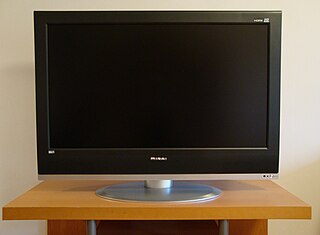
A liquid-crystal-display television is a television set that uses a liquid-crystal display to produce images. It is by far the most widely produced and sold type of television display. LCD TVs are thin and light, but have some disadvantages compared to other display types such as high power consumption, poorer contrast ratio, and inferior color gamut.
This is a comparison of various properties of different display technologies.

Samsung Display Co., Ltd (Korean: 삼성디스플레이) is a manufacturer of OLED and QD-OLED panels, and former manufacturer of liquid crystal displays (LCDs). Display markets include smartphones, TVs, laptops, computer monitors, smartwatches, virtual reality, handheld game consoles, and automotive applications.
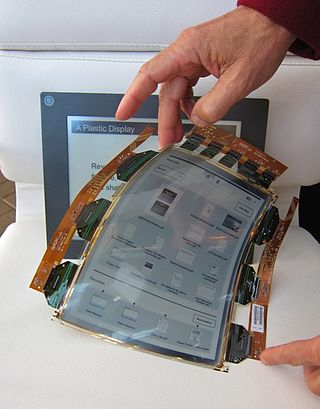
A flexible display or rollable display is an electronic visual display which is flexible in nature, as opposed to the traditional flat screen displays used in most electronic devices. In recent years there has been a growing interest from numerous consumer electronics manufacturers to apply this display technology in e-readers, mobile phones and other consumer electronics. Such screens can be rolled up like a scroll without the image or text being distorted. Technologies involved in building a rollable display include electronic ink, Gyricon, Organic LCD, and OLED.
Display motion blur, also called HDTV blur and LCD motion blur, refers to several visual artifacts that are frequently found on modern consumer high-definition television sets and flat panel displays for computers.
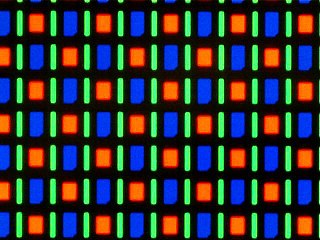
AMOLED is a type of OLED display device technology. OLED describes a specific type of thin-film-display technology in which organic compounds form the electroluminescent material, and active matrix refers to the technology behind the addressing of pixels.

A quantum dot display is a display device that uses quantum dots (QD), semiconductor nanocrystals which can produce pure monochromatic red, green, and blue light. Photo-emissive quantum dot particles are used in LCD backlights or display color filters. Quantum dots are excited by the blue light from the display panel to emit pure basic colors, which reduces light losses and color crosstalk in color filters, improving display brightness and color gamut. Light travels through QD layer film and traditional RGB filters made from color pigments, or through QD filters with red/green QD color converters and blue passthrough. Although the QD color filter technology is primarily used in LED-backlit LCDs, it is applicable to other display technologies which use color filters, such as blue/UV active-matrix organic light-emitting diode (AMOLED) or QNED/MicroLED display panels. LED-backlit LCDs are the main application of photo-emissive quantum dots, though blue organic light-emitting diode (OLED) panels with QD color filters are being researched.

4K resolution refers to a horizontal display resolution of approximately 4,000 pixels. Digital television and digital cinematography commonly use several different 4K resolutions. In television and consumer media, 3840 × 2160 with a 16:9 aspect ratio is the dominant 4K standard, whereas the movie projection industry uses 4096 × 2160.
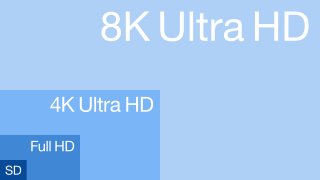
8K resolution refers to an image or display resolution with a width of approximately 8,000 pixels. 8K UHD is the highest resolution defined in the Rec. 2020 (UHDTV) standard.

Japan Display Inc., commonly called by its abbreviated name, JDI, is the Japanese display technology joint venture formed by the merger of the small and medium-sized liquid crystal display businesses of Sony, Toshiba, and Hitachi.
MicroLED, also known as micro-LED, mLED or μLED is an emerging flat-panel display technology consisting of arrays of microscopic LEDs forming the individual pixel elements. Inorganic semiconductor microLED (μLED) technology was first invented in 2000 by the research group of Hongxing Jiang and Jingyu Lin of Texas Tech University while they were at Kansas State University. The first high-resolution and video-capable InGaN microLED microdisplay in VGA format was realized in 2009 by Hongxing Jiang and Jingyu Lin and their colleagues at Texas Tech University and III-N Technology, Inc. via active driving of microLED array by a complementary metal-oxide semiconductor (CMOS) IC. Compared to widespread LCD technology, microLED displays offer better contrast, response times, and energy efficiency.

16K resolution is a display resolution with approximately 16,000 pixels horizontally. The most commonly discussed 16K resolution is 15360 × 8640, which doubles the pixel count of 8K UHD in each dimension, for a total of four times as many pixels. This resolution has 132.7 megapixels, 16 times as many pixels as 4K resolution and 64 times as many pixels as 1080p resolution.

Pimax is a technology company specializing in virtual reality hardware products.